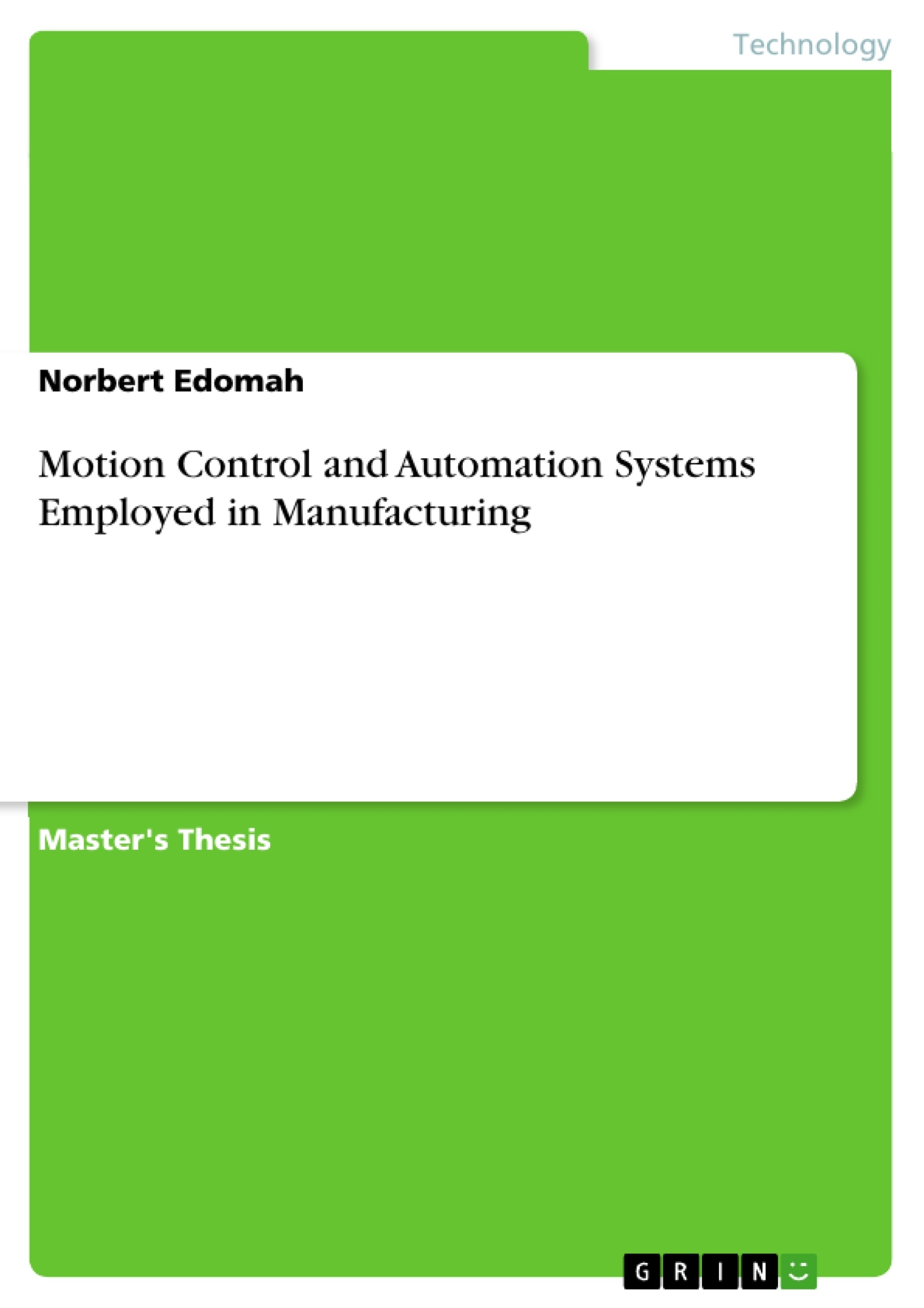Motion control has emerged as one of the most dynamic technologies in manufacturing. The current shift from mechanical control systems towards electronic servo control systems promises to increase process speeds by 50% or more, depending on application. The transfer and assembly lines have had a powerful impact in automating our factories with the primary goal of reduction of labour content while holding on to the financial justification labelled as economy of scale. Motion controllers are components that range from ON/OFF devices with simple linear controllers to complex, user programmable modules that act as controllers
within complex integrated multi-axis motion systems. Applications include all types of industrial processing, packaging, and machining/forming operations. This thesis will focus on analysis of basic motion control theory, sensors and actuators used in
motion control, adapting fieldbus technology in motion control systems, and developments, trends and application of motion control technology in different engineering disciplines.
Inhaltsverzeichnis (Table of Contents)
- CHAPTER 1: INTRODUCTION
- 1.1 Motion Control Classification
- 1.2 Kinds of Controlled Motion
- CHAPTER 2: POSITION/PROXIMITY SENSORS FOR MOTION CONTROL
- 2.1 Limit Switches
- 2.2 Proximity Sensors
- 2.2.1 Inductive proximity sensors
- 2.2.2 Capacitive proximity Sensors
- 2.2.3 Ultrasonic proximity sensors
- 2.2.4 Photoelectric proximity sensors
- CHAPTER 3: FLUID POWER (PNEUMATIC/HYDRAULIC) ACTUATORS
- 3.1 Valves
- 3.1.1 Pressure control valves
- 3.1.2 Reducing/regulating valves
- 3.1.3 Sequence valves
- 3.1.4 Flow control valves
- 3.1.5 Direction control valves
- 3.1.6 Check valve
- 3.2 Cylinders
- CHAPTER 4 ELECTRICAL ACTUATORS
- 4.1 Mechanical switches
- 4.2 Solid state switches
- 4.3 Solenoids
- 4.4 Relays
- 4.5 Electric motors
- CHAPTER 5: ADAPTING FIELDBUS TECHNOLOGY IN MOTION CONTROL SYSTEMS
- 5.1 Actuator Sensor Interface (AS-i)
- 5.2 PROFIBUS
- 5.3 Industrial Ethernet
- CHAPTER 6: APPLICATIONS & DEVELOPMENTS IN MOTION CONTROL & AUTOMATION TECHNOLOGY
- 6.1 Applications and trends of motion control in robotics
- 6.2 Application of fluid power in motion control technology.
- 6.3 Application of motion control technology in plant automation
Zielsetzung und Themenschwerpunkte (Objectives and Key Themes)
This thesis focuses on the analysis of motion control theory, sensors and actuators used in motion control, adapting fieldbus technology in motion control systems, and the development, trends, and application of motion control technology across various engineering disciplines. The main objective is to provide a comprehensive understanding of the role of motion control in modern manufacturing processes.
- Motion control classification and types of controlled motion
- Sensors and actuators utilized in motion control systems
- Integration of fieldbus technology for enhanced motion control systems
- Applications of motion control in diverse engineering fields, including robotics and plant automation
- Advancements and trends shaping the future of motion control technology
Zusammenfassung der Kapitel (Chapter Summaries)
Chapter 1 introduces the concept of motion control, delving into its classification and types of controlled motion. It sets the foundation for understanding the broader context of motion control within modern manufacturing processes.
Chapter 2 explores position/proximity sensors, essential components in motion control systems. It examines the function and applications of limit switches and various proximity sensors, including inductive, capacitive, ultrasonic, and photoelectric sensors.
Chapter 3 focuses on fluid power actuators, specifically pneumatic and hydraulic actuators. This chapter covers different types of valves, including pressure control, reducing/regulating, sequence, flow control, direction control, and check valves, alongside the operation of cylinders.
Chapter 4 delves into electrical actuators, encompassing mechanical and solid-state switches, solenoids, relays, and electric motors. It provides a comprehensive analysis of these actuators, their principles of operation, and their role in motion control systems.
Chapter 5 investigates the adaptation of fieldbus technology in motion control systems. It examines the benefits and applications of fieldbus technologies like Actuator Sensor Interface (AS-i), PROFIBUS, and Industrial Ethernet, highlighting their impact on modern motion control systems.
Chapter 6 explores the diverse applications and developments of motion control technology across various engineering fields. It focuses on the role of motion control in robotics, fluid power systems, and plant automation, showcasing its significance in contemporary manufacturing processes.
Schlüsselwörter (Keywords)
The key focus of this thesis is on motion control, encompassing sensor technologies, actuators, fieldbus integration, and applications within various engineering disciplines. Keywords include motion control, sensors, actuators, fieldbus, robotics, plant automation, manufacturing, automation, industrial processes, industrial control, servo systems, programmable logic controllers (PLCs).
- Citation du texte
- Norbert Edomah (Auteur), 2010, Motion Control and Automation Systems Employed in Manufacturing, Munich, GRIN Verlag, https://www.grin.com/document/154079



